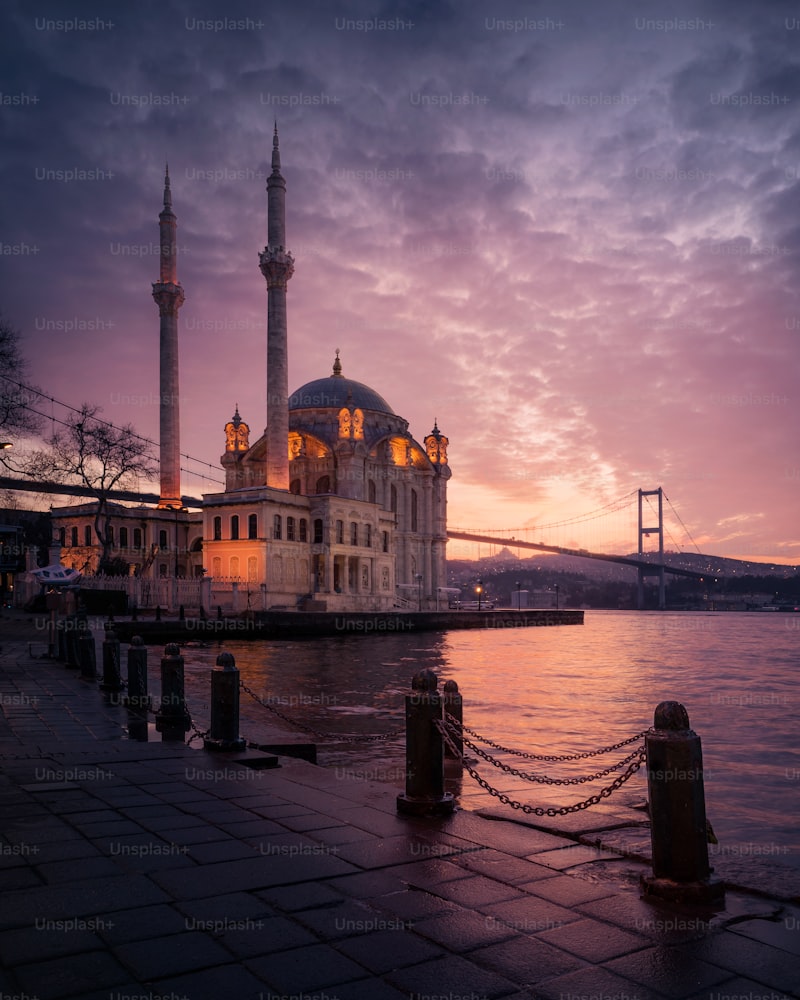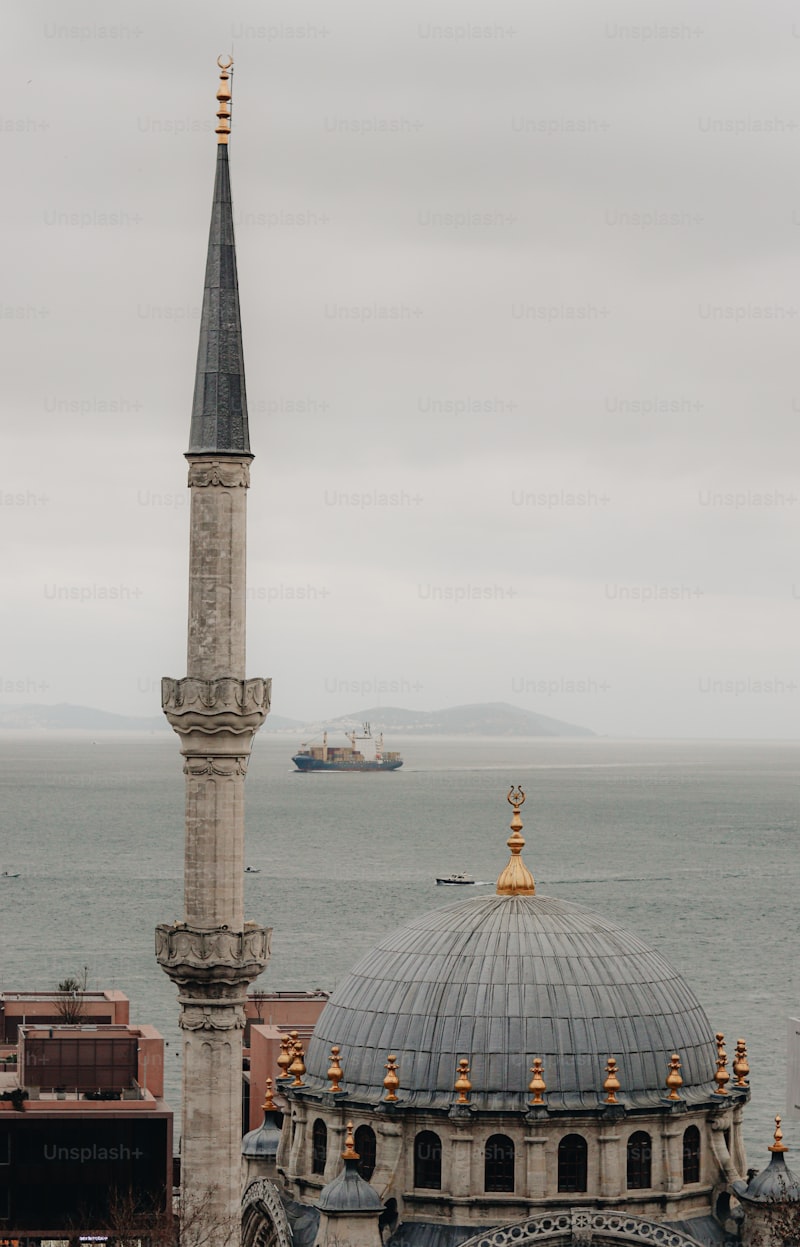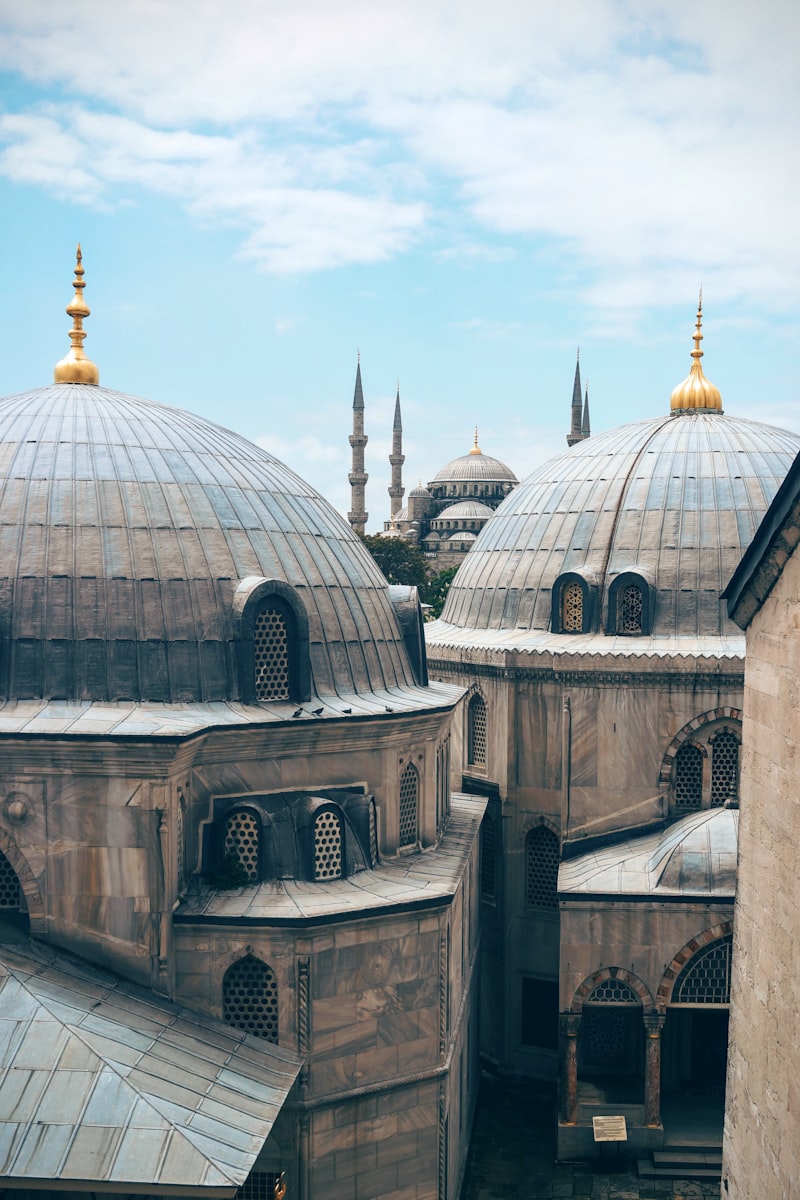Nearby, the Blue Mosque, officially known as the Sultan Ahmed Mosque, enchants with its six minarets and stunning blue tile work, giving it a name that echoes across continents. As the sunlight dances on its domes and minarets, one can’t help but marvel at the craftsmanship that defines Ottoman architecture.
Not far away lies the Topkapi Palace, once the residence of Ottoman sultans and their court. Its opulent pavilions and gardens offer a glimpse into the lavish lifestyle of the Ottoman Empire’s rulers. Walking through its halls, adorned with priceless artifacts and relics, feels like stepping into a living museum frozen in time.
Venturing across the Golden Horn, the Galata Tower looms large over the city’s skyline. Built by the Genoese in the 14th century, its panoramic views from the top encapsulate Istanbul’s timeless beauty, where East meets West in a harmonious blend.
The Grand Bazaar, with its labyrinthine alleys and vibrant stalls, remains a pulsating heart of commerce and culture since the 15th century. Here, the scent of spices mingles with the sight of exquisite carpets and jewelry, inviting visitors to haggle and immerse themselves in Istanbul’s bustling marketplace.

Each step in Istanbul is a journey through epochs, where ancient relics and modern life intertwine seamlessly. From the majestic palaces to the bustling bazaars, every corner tells a story of empires risen and fallen, leaving an indelible mark on this city that straddles two continents.
Unveiling Istanbul’s Timeless Treasures: Exploring Its Iconic Historic Wonders
Imagine wandering through the Hagia Sophia, a marvel that has stood the test of time since its construction in the 6th century. Once a Byzantine cathedral, later an Ottoman mosque, and now a museum, it enchants visitors with its massive dome and intricate mosaics. Each step inside whispers stories of empires and architectural brilliance.
Not far from the Hagia Sophia lies the majestic Blue Mosque, officially known as the Sultan Ahmed Mosque. Adorned with cascading domes and six slender minarets, it’s a masterpiece of Ottoman architecture. Step inside to be dazzled by its cavernous interior, awash with blue Iznik tiles that lend the mosque its nickname.
A short stroll away, the Topkapi Palace beckons with its opulent chambers and lush courtyards. Once the seat of Ottoman sultans, it now houses a dazzling collection of relics, from the glittering jewels of the Imperial Treasury to the serene gardens overlooking the Bosphorus.
For a taste of Istanbul’s bustling past, venture into the Grand Bazaar, where shop-lined alleys brim with treasures both old and new. Lose yourself in the maze of over 4,000 shops selling everything from spices to carpets, each transaction echoing centuries of trade and tradition.
Crossing the Galata Bridge offers a glimpse into the city’s maritime heritage. Watch as fishing boats bob on the Golden Horn, framed by the silhouette of the iconic Galata Tower. Originally built by the Genoese in the 14th century, its panoramic views of Istanbul are as breathtaking today as they were centuries ago.
Whether savoring the aromas of Turkish coffee in a historic café or cruising the Bosphorus at sunset, Istanbul’s timeless treasures promise to captivate and inspire. Each monument, each neighborhood, tells a story of resilience and reinvention, inviting visitors to uncover the layers of history that make Istanbul one of the world’s most enchanting cities.
Journey Through History: Istanbul’s Top 5 Must-See Ancient Sites
Istanbul, a city where every corner whispers tales of its rich history, is a treasure trove of ancient wonders waiting to be explored. If you’re planning a journey through time in Istanbul, make sure these top 5 ancient sites are on your list.
-
Hagia Sophia: Once a Byzantine cathedral, later an Ottoman mosque, and now a museum, Hagia Sophia stands as a testament to Istanbul’s cultural richness. Its grand dome and stunning mosaics are awe-inspiring.
-
Topkapi Palace: Serving as the residence of Ottoman sultans for centuries, Topkapi Palace offers a glimpse into royal life. Wander through its opulent courtyards, visit the Harem, and admire treasures like the Spoonmaker’s Diamond.
-
Blue Mosque (Sultan Ahmed Mosque): With its six towering minarets and a cascade of domes, the Blue Mosque is an architectural marvel. Step inside to marvel at its intricate blue tiles that give it its name.
-
Basilica Cistern: Delve underground into the Basilica Cistern, an ancient reservoir built during the reign of Emperor Justinian I. Its haunting atmosphere, supported by rows of Medusa-head columns, makes it a mysterious experience.
-
Theodosian Walls: Stretching across Istanbul, the Theodosian Walls are a reminder of the city’s fortification during the Byzantine era. Walk along these ancient ramparts and imagine the city’s past defenses.
Each of these sites offers a unique glimpse into Istanbul’s layered history, blending influences from Byzantine, Roman, and Ottoman empires. Whether you’re a history enthusiast or simply curious about the past, exploring these ancient sites promises an unforgettable journey through Istanbul’s vibrant history.
From Byzantium to Constantinople: Istanbul’s Evolution of Architectural Marvels
Imagine walking through the bustling streets of Istanbul, where every corner whispers tales of a city steeped in history. Istanbul, formerly known as Byzantium and later Constantinople, is not just a city but a living museum of architectural wonders that have evolved over centuries.
The journey of Istanbul’s architectural marvels began over 2,600 years ago when it was founded as Byzantium by Greek colonists. Nestled between Europe and Asia, this strategic location made it a coveted city throughout history. As Byzantium, the city flourished with Greek and Roman influences, seen in structures like the Hippodrome and the Baths of Zeuxippus.
However, the city truly came into its own when Emperor Constantine the Great declared it the new capital of the Roman Empire in 330 AD, renaming it Constantinople. This marked the beginning of an architectural transformation that would shape the city’s skyline for centuries to come. The Hagia Sophia, a masterpiece of Byzantine architecture commissioned by Emperor Justinian I, stands as a testament to this golden age. Its massive dome and intricate mosaics continue to awe visitors today.
Over the centuries, Constantinople became the epicenter of the Byzantine Empire, blending Roman grandeur with Eastern opulence. The city walls, fortified by Emperor Theodosius II, defended against numerous sieges and stood as a symbol of Byzantine strength. Meanwhile, the Chora Church dazzled with its stunning mosaics and frescoes, showcasing the artistic zenith of the Byzantine era.
In 1453, the city fell to the Ottomans under Mehmed the Conqueror, who renamed it Istanbul. This marked yet another chapter in its architectural evolution. The Hagia Sophia was converted into a mosque, blending Byzantine architecture with Islamic elements such as minarets and calligraphy. The Sultan Ahmed Mosque, also known as the Blue Mosque, built in the early 17th century, exemplifies the harmonious fusion of Byzantine and Ottoman styles.
Hidden Gems of Istanbul’s Ancient Past: Discovering Forgotten Treasures
One such gem is the Basilica Cistern, an underground marvel built in the 6th century during the reign of Emperor Justinian I. As you descend into its depths, you’re greeted by rows of ancient columns rising majestically from the water. It feels almost mystical, as if you’ve stepped into a scene from a historical novel. This cistern once held vast amounts of water for the city above, a testament to the ingenuity of Byzantine engineering.
Another marvel is the Chora Church, renowned for its stunning mosaics and frescoes that depict scenes from the life of Christ. Each mosaic is a masterpiece, with colors so vivid and storytelling so intricate that you can’t help but be captivated. Walking through the church is like unraveling a visual narrative of Byzantine artistry, where every detail is a brushstroke in the tapestry of history.
For those who seek a quieter escape, the Suleymaniye Mosque offers not only spiritual solace but also architectural splendor. Built by the great Ottoman architect Mimar Sinan, it stands as a testament to the golden age of the Ottoman Empire. The mosque’s serene courtyards and towering minarets offer a panoramic view of Istanbul, a city where East meets West in a harmonious blend.
And then there’s the Grand Bazaar, a labyrinthine marketplace that has been bustling with activity since the 15th century. Here, you can lose yourself among the myriad stalls selling everything from spices to jewelry, carpets to ceramics. It’s a sensory overload of sights, sounds, and smells—an experience that immerses you in Istanbul’s vibrant cultural tapestry.
Preserving Heritage: Istanbul’s Efforts in Safeguarding Its Historic Landmarks
One of the most remarkable aspects of Istanbul is its unwavering commitment to preserving its heritage. Amidst the hustle and bustle of modern life, the city has taken significant strides to safeguard its historic landmarks. These efforts are not merely about maintaining old buildings but about cherishing the legacy they represent. Istanbul understands that its heritage is not just a part of its past but a beacon guiding its future.
Take the Hagia Sophia, for example. Originally built as a cathedral in the 6th century AD, it later became a mosque and now serves as a museum. The meticulous restoration work undertaken here is not just about repairing walls and domes but about revitalizing a symbol of cultural synthesis and architectural marvel.
Similarly, the Topkapi Palace, once the administrative center of the Ottoman Empire, has been meticulously preserved to offer visitors a glimpse into the opulent lifestyle of sultans and their courts. Each chamber, each courtyard tells a story of grandeur and power, meticulously maintained to ensure that future generations can appreciate its significance.
Istanbul’s efforts in preserving its historic landmarks go beyond mere conservation; they aim to create a lasting impact on those who visit. Imagine standing amidst the ancient walls of the Theodosian Land Walls, feeling the weight of history as you gaze upon the same views that once guarded the city against invaders. It’s not just about bricks and stones; it’s about connecting with the past in a tangible way.
The city’s commitment to heritage preservation is a testament to its respect for history and culture. By safeguarding these landmarks, Istanbul ensures that the richness of its past continues to inspire and educate generations to come. As you explore its streets and monuments, you can’t help but marvel at how Istanbul seamlessly blends the old with the new, honoring its legacy while embracing the future.
A Walk Through Time: Istanbul’s Oldest Streets and Monuments
Ever wondered what it’s like to stroll through history? Istanbul, a city woven with tales of antiquity, offers a fascinating journey through its oldest streets and monuments. Each cobblestone whispers secrets of empires past, offering a glimpse into the rich tapestry of civilizations that have shaped this iconic city.

One of the most captivating aspects of Istanbul is its ability to blend the ancient with the modern seamlessly. As you wander through the narrow alleys of Sultanahmet, you’ll encounter the majestic Hagia Sophia, a marvel of Byzantine architecture standing as a testament to Istanbul’s glorious past. Originally built as a cathedral in the 6th century, it later became a mosque and now serves as a museum, embodying the city’s diverse cultural heritage.
Just a stone’s throw away lies the Blue Mosque, known for its stunning blue tiles and six minarets that punctuate the skyline. Built in the early 17th century during the Ottoman era, this architectural masterpiece is a symbol of Islamic artistry and remains an active place of worship.
Venturing further into the heart of Istanbul, you’ll discover the Grand Bazaar, a labyrinth of covered streets lined with shops selling everything from spices to jewelry. Established in the 15th century, it is one of the world’s oldest and largest covered markets, where bargaining is an art form and every corner hides a treasure waiting to be uncovered.
For those seeking a quieter retreat, the charming streets of Balat beckon with their colorful houses and eclectic cafes. Once the heart of Istanbul’s Jewish community, Balat’s quaint atmosphere and historical synagogues offer a glimpse into the city’s multicultural past.

As you navigate these ancient streets, each step is a journey through time, where every corner reveals a story waiting to be told. Whether you’re drawn to the grandeur of imperial palaces or the intimacy of neighborhood haunts, Istanbul’s oldest streets and monuments promise an unforgettable adventure through centuries of history.
This article aims to capture the essence of Istanbul’s historical richness while engaging the reader with vivid descriptions and a narrative style that invites exploration.
Frequently Asked Questions
Can you recommend guided tours of Istanbul’s historic sites?
Discover the best guided tours of Istanbul’s historic sites with our expert recommendations. Explore the rich history and cultural heritage of Istanbul through curated tours designed to showcase its iconic landmarks and hidden gems.
How old are the historic structures in Istanbul?
Learn about the age of historic structures in Istanbul, tracing back centuries to various periods such as the Byzantine and Ottoman eras. Gain insights into their architectural significance and cultural heritage.
Which historic wonders in Istanbul are UNESCO World Heritage Sites?
Discover the historic wonders of Istanbul recognized as UNESCO World Heritage Sites, including the awe-inspiring Hagia Sophia, the majestic Blue Mosque, the grand Topkapi Palace, and the ancient city walls.
What are the top historic landmarks to visit in Istanbul?
Discover Istanbul’s rich history through its top historic landmarks. Explore the majestic Hagia Sophia, once a Byzantine cathedral and Ottoman mosque. Visit the iconic Blue Mosque with its intricate tilework and towering minarets. Wander through the ancient walls of Constantinople, offering a glimpse into the city’s past defenses. Don’t miss the Topkapi Palace, home to Ottoman sultans and showcasing opulent architecture and artifacts.
Why is Istanbul known for its historic architecture?
Discover why Istanbul is renowned for its historic architecture. Learn about its rich cultural heritage spanning centuries, featuring iconic landmarks like the Hagia Sophia and Topkapi Palace. Understand how Byzantine, Ottoman, and Roman influences have shaped the city’s distinctive skyline.


